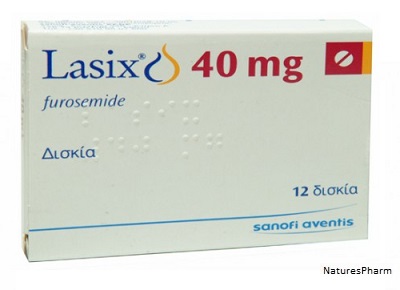What is Lasix?
Lasix is referred to the class of loop diuretics providing fast approaching, strong and short diuretic effect. When administered periorally, it acts within 20 – 30 minutes, reaching a peak after 1 – 2 hours with a duration of 3-4 to 6 hours.
Lasix is largely produced in the form of white valium tablets of creme color with facets. 1 tablet typically contains an active substance of furosemide (40 mg) and a number of other ingredients: milk sugar, potato starch, starch 1500 and magnesium stearate. Furosemide provides a strong diuretic and natriuretic action; it accelerates potassium, calcium and magnesium ions excretion.
In case of heart failure, the preparation reduces the preload on the heart within 20 minutes. The maximum hemodynamic effect is achieved by the second hour after the drug administration due to decreasing tone of the veins, decreasing blood volume and interstitial fluid. A hypotensive effect through sodium chloride amplified excretion, vascular reaction of smooth muscle to vasoconstrictor impact reduction and circulating blood volume decrease.
Lasix: indications for use
Lasix is absorbed quickly and completely, its bioavailability (ingestion) level is equal to 60-70%; the biotransformation in the liver. The medication’s components are mainly excreted by the kidneys.
The drug is characterized by a relatively quick effect. In case of intravenous administration the diuretic effect develops within minutes, in ingestion – the effect is achieved within the first hour. In intravenous administration the effect lasts for 11/2-3 hours and 4 hours in case Lasix is taken periorally. A quick effect in intravenous administration is promotes the use of medication in particular in emergency cases (e.g. pulmonary edema or similar tough cases).
• Lasix is typically prescribed as a diuretic during insufficient and extensive blood circulation in consequence of heart failures, liver cirrhosis characterized by portal hypertension, chronic and acute renal failures, acute pulmonary edemas, barbiturate poisonings and eclampsias.
• Unlike thiazides, Lasix active ingredient doesn’t reduce glomerular filtration rate, in connection with which it is used in chronic renal failure (in testimony to the use of diuretics). In some cases Lasix has a diuretic effect where other drugs are useless.
• The medicament’s efficiency in circulatory failures is also achieved with by virtue of direct peripheral vasodilator effect. The first phase, developing for a half an hour after the drug is administered, depends upon its peripheral vessels impact, and the 2nd, or late phase , observed within 1-2 hours after injection, depends on diuretic action.
• Use Lasix for the relief of severe hypertensive crises.
Lasix: dosage recommendations
Lasix pills are recommended to be taken on an empty stomach without chewing and drinking plenty of water. When Furosemide is administered, the minimum doses to achieve the desired effect are recommended to be used. The maximum daily dose for adults is equal to 1500 mg. The Initial single dose in children is determined by the rate of 1-2 mg/kg of body weight with a possible increase to a maximum dose of 6 mg/kg. An extra dose of the drug is administered no more than 6 hours since the previous pill is taken; an additional dose is also determined by the physician individually depending on particular indications.
Lasix: administration regimen in adults
• Edema syndrome in patients with chronic heart failure. The initial dose of 20-80 mg is selected depending on the diuretic response. It is recommended to divide the daily dose into 2-3 intakes.
• Edema syndrome in patients with chronic renal failure. Those patients suffering from chronic renal failure require careful selection of the dose. A gradual increase is recommended, so that the fluid loss occurred gradually (in early treatment a loss of liquids is possible, resulting in about 2 kg of body weight loss). The recommended initial dose - 40-80 mg, defined in accordance with the diuretic response. All the daily doses should be taken once or divided into two doses. In patients with hemodialysis, the usual maintenance dose is equal to 250-1500 mg.
• Edema in nephrotic syndrome. The initial dose of 40-80 mg is prescribed according to diuretic response. The daily dose may be taken as a single dose or divided into several doses.


